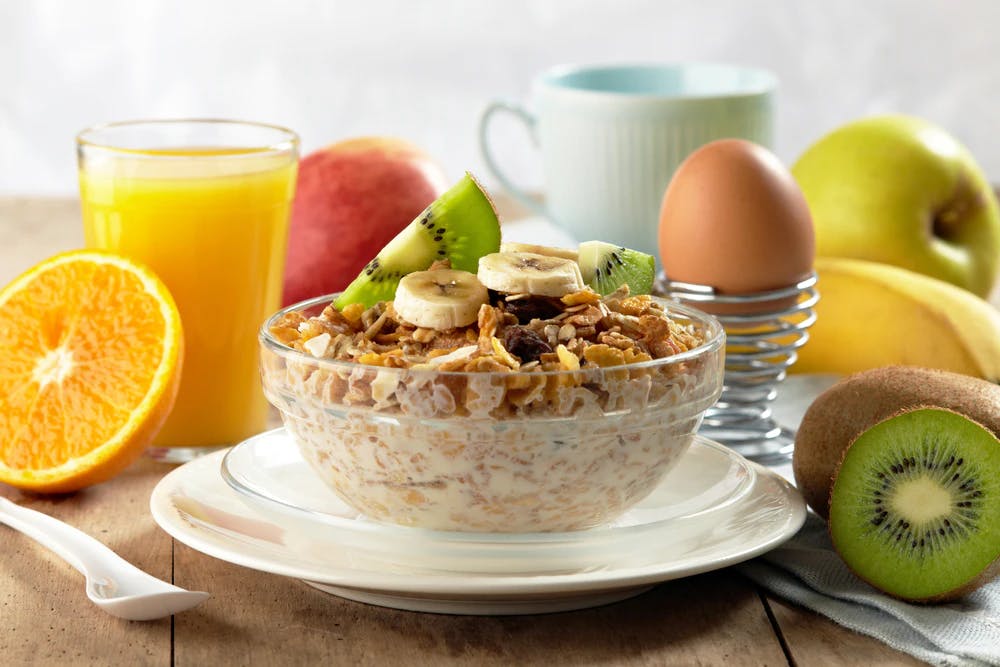I Ditched My College Meal Plan And You Should Too
Colleges spend extra on food during orientation to impress parents, but several weeks in the quality and variety decline. If you opt out of the college meal plan, you can eat better, stay healthier, and save a lot of money (with a little effort).

Why Make Your Own Food?
Because, even besides being careful with allergies, one of the best favors you can give yourself is keeping your body healthy and vigorous through a good/clean diet. When I started out as a freshman in the college dorm, I had to obtain an exemption from the university’s meal plan due to digestive intolerances. But I also chose to because making my own food was: (a) much cheaper—I ended up eating well on a budget of less than $250 per month, vs.a $5,000 meal plan at $120 per week—and (b) much healthier, since the cafeteria served low-quality food.
Eating clean kept my immune system strong; I was never sick as a freshman.
My Plan vs. Cafeteria
With my sensitivities, I had to steer clear of soy, gluten, rice, almonds, beans, and dairy. My doctor said I had a lack of enzymes and a type of Celiac disease. Not all of the above were full-blown allergies, and I wouldn’t die if I cheated a bit sometimes, but I couldn’t have them in my daily menu and function well as a student. Even the “gluten-free” option was a no-go (rice).
This situation worked out great though; I definitely preferred it to eating the junk at the cafeteria that was usually old/sketchy/undercooked. How many people have had food poisoning from cafeteria food? I knew plenty. I was used to cooking from scratch and eating organic. Plus, the cafeteria is a big culprit for the Freshman 15.

The Socializing Dilemma
The flip-side was that, since meals are the social time with everyone eating together in the cafeteria, I had to take extra time to go (sneak) into the dining hall to eat a packed meal (or protein shake) with friends, instead of eating separately with the commuting students or alone in my room. Sometimes I would just eat in my dorm before or after a meal, but still go to the cafeteria, hop tables, and talk to people.
Sometimes I would just eat in my dorm before or after a meal, but still go to the cafeteria, hop tables, and talk to people.
The Big Question: How To Eat off the College Meal Plan in the Dorm?
Can’t vs. Can
After learning what I couldn’t eat, so many amazed people would then ask what I could eat. I sometimes leaned more towards keto/paleo, but in general I just ate clean and balanced with good proteins/fats/carbs. I could/would eat: eggs, meat (usually more poultry than red meat), fish, quinoa, oats, lentils, some nuts/seeds, butter/olive oil, coconut (milk), most fruits and veggies. That opens up the horizon, right?
I limited super sweet fruits (like pineapple/mangoes) and really starchy vegetables (corn/potatoes). Of course, it’s fun to have a treat sometimes, but when possible, it’s good to try and find a healthy substitute. And after eating healthily, the taste buds eventually adjust and don’t crave the guilty junk as much, if at all.
Stocking Up
I bought a crock-pot, a shaker bottle (for my daily, plant-based protein shake), a mini-fridge, a 4-qt. pot, an electric kettle, and some dishes/utensils and mixing items. I even brought a little cast-iron pan from home. I felt prepared! For shopping, I used the cheapest places with natural/organic foods available, usually Trader Joe’s, Aldi, and Walmart.
Cooking and Storing
Happily, there was a kitchenette on a nearby dorm floor that I could cook in. It was annoying always having to load everything into my laundry basket to bring over, but I was grateful I had that option available since hot-plates weren’t allowed in the dorm rooms (I didn’t use microwaves). Obviously, I didn’t have tons of free time to cook fancy. I ended up cooking in the kitchenette about twice a week. When I did cook, I made extra to store in fridge containers and even cooked other food at the same time to store.
When I did cook, I made extra to store in fridge containers and even cooked other food at the same time to store.
For example, the first Saturday there, I started crock-pot chicken, then cooked a pot of quinoa in the kitchenette. For the next five days of that first school week, I ate chicken and quinoa w/veggies for dinner! After the chicken was cooked, I transferred it to a fridge container, then used the leftover broth to make a lentil soup.
As I found, it’s a booster being happy about what you’re eating, and eating good food, instead of always cramming a snack or a packaged deal for survival’s sake. When possible, it’s important to add color/variety to the plate. For example, a tuna salad sandwich is way prettier with cucumber slices and carrot shreds; or skip the bread and eat it with chopped veggies. It doesn’t take much effort to toss a few olives or tomatoes on a salad. Stir-fries are another easy meal option. I also tried to cook with a friend every week to make it fun, but also to force myself to have a sit-down meal. So, be sure to take the time to feed yourself well. With planning, it doesn’t have to be time-consuming.
Planning
Sometimes we’re too busy to think ahead and will just pull a snack out when we're hungry. That’s okay. I found that making a small effort, though, and planning ahead while doing something else (multi-tasking) is very doable. It doesn’t have to be an entire weekly list made out; sometimes it’s easiest to plan as you go. For example, maybe think of the next day’s menu while brushing teeth at night. Or, if there are certain ingredients available, imagine what they could make. Try to change up meals to keep things exciting and to have good variation!